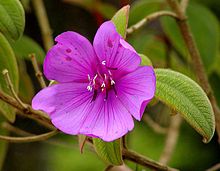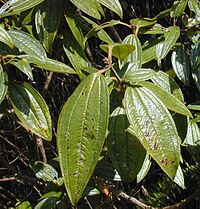- Melastomataceae
-
Melastomataceae 
Tibouchina semidecandra at Strybing Arboretum, San Francisco Scientific classification Kingdom: Plantae (unranked): Angiosperms (unranked): Eudicots (unranked): Rosids Order: Myrtales Family: Melastomataceae
Juss.Genera See text.
The family Melastomataceae (alternatively Melastomaceae) is a taxon of dicotyledonous flowering plants found mostly in the tropics (two thirds of the genera are from the New World tropics) comprising some 200 genera and 4500 species. Melastomes are annual or perennial herbs, shrubs, or small trees.
The leaves of melastomes are somewhat distinctive, being opposite, decussate, and usually with 3-7 longitudinal veins arising either from the base of the blade, plinerved (inner veins diverging above base of blade), or pinnately nerved with three or more pairs of primary veins diverging from the mid-vein at successive points above the base.
Flowers are perfect, and borne either singly or in terminal or axillary, paniculate cymes.
A number of melastomes are regarded as invasive species once naturalized in tropical and subtropical environments outside of their normal range. Examples are Koster's curse and Miconia calvescens, but many other species are involved.
Genera
- Acanthella
- Aciotis
- Acisanthera
- †Acrovena
- Adelobotrys
- Allomaieta
- Allomorphia
- Alloneuron
- Amphiblemma
- Amphitoma
- Amphorocalyx
- Anaectocalyx
- Anerincleistus
- Antherotoma
- Appendicularia
- Arthrostemma
- Aschistanthera
- Astrocalyx
- Astronia
- Astronidium
- Axinaea
- Barthea
- Beccarianthus
- Behuria
- Bellucia
- Benevidesia
- Bertolonia
- Bisglaziovia
- Blakea
- Blastus
- Boerlagea
- Boyania
- Brachyotum
- Brachypremna
- Bredia
- Brittenia
- Bucquetia
- Cailliella
- Calvoa
- Calycogonium
- Cambessedesia
- Campimia
- Carionia
- Castratella
- Catanthera
- Catocoryne
- Centradenia
- Centradeniastrum
- Centronia
- Chaetolepis
- Chaetostoma
- Chalybea
- Charianthus
- Cincinnobotrys
- Clidemia
- Comolia
- Comoliopsis
- Conostegia
- Copedesma
- Creaghiella
- Creochiton
- Cryptophysa
- Cyanandrium
- Cyphostyla
- Cyphotheca
- Dalenia
- Desmoscelis
- Dicellandra
- Dicerospermum
- Dichaetanthera
- Dinophora
- Dionycha
- Dionychastrum
- Diplarpea
- Diplectria
- Dissochaeta
- Dissotis
- Dolichoura
- Driessenia
- Eisocreochiton
- Enaulophyton
- Eriocnema
- Ernestia
- Farringtonia
- Feliciadamia
- Felliciadamia
- Fordiophyton
- Fritzchia
- Graffenrieda
- Gravesia
- Guyonia
- Henriettea
- Henriettella
- Heterocentron
- Heterotis
- Heterotrichum
- Huberia
- Huilaea
- Hylocharis
- Hypenanthe
- Kendrickia
- Kerriothyrsus
- Killipia
- Kirkbridea
- Lavoisiera
- Leandra
- Lijndenia
- Lithobium
- Llewelynia
- Loreya
- Loricalepis
- Macairea
- Macrocentrum
- Macrolenes
- Maguireanthus
- Maieta
- Mallophyton
- Marcetia
- Mecranium
- Medinilla
- Meiandra
- Melastoma
- Melastomastrum
- Memecylon
- Menendezia
- Meriania
- Merianthera
- Miconia
- Microlepis
- Microlicia
- Mommsenia
- Monochaetum
- Monolena
- Mouriri
- Myriaspora
- Myrmidone
- Neblinanthera
- Necramium
- Neodriessenia
- Nepsera
- Nerophila
- Ochthephilus
- Ochthocharis
- Omphalopus
- Opisthocentra
- Oritrephes
- Orthogoneuron
- Osbeckia
- Ossaea
- Otanthera
- Oxyspora
- Pachyanthus
- Pachycentria
- Pachyloma
- Pentossaea
- Phainantha
- Phainanthe
- Phyllagathis
- Pilocosta
- Plagiopetalum
- Pleiochiton
- Plethiandra
- Podocaelia
- Pogonanthera
- Poikilogyne
- Poilannammia
- Poteranthera
- Preussiella
- Pseudodissochaeta
- Pseudoernestia
- Pseudosbeckia
- Pternandra
- Pterogastra
- Pterolepis (Pterolepsis?)
- Rhexia
- Rhynchanthera
- Rousseauxia
- Sagraea (?)
- Salpinga
- Sandemania
- Sarcopyramis
- Schwackaea
- Scorpiothyrsus
- Siphanthera
- Sonerila
- Spathandra
- Sporoxeia
- Stanmarkia
- Stapfiophyton
- Stenodon
- Stussenia
- Styrophyton
- Sussenia
- Svitramia
- Tateanthus
- Tayloriophyton
- Tessmannianthus
- Tetraphyllaster
- Tetrazygia
- Tibouchina
- Tibouchinopsis
- Tigridiopalma
- Tococa
- Topobea
- Trembleya
- Trigynia
- Triolena
- Tristemma
- Tryssophyton
- Tylanthera
- Vietsenia
- Votomita
- Warneckea
External links
Categories:- Melastomataceae
- Myrtales families
Wikimedia Foundation. 2010.

